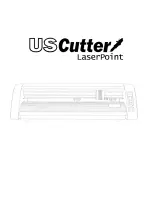
7.3 Oxygen Control Valve Disassembly/Reassembly
WARNING!
Oxygen mixed with oil or grease reacts explosively. Always keep oil
and grease away from oxygen cylinders, valves, regulators, hoses and fittings. Use
only certified oxygen compatible silicon lubricants on the valve stem and valve stem
o-ring.
Note:
The oxygen control valve is disassembled as part of a major overhaul of the
torch when damaged, obstructed or when an oxygen leak is detected. During the
normal course of operations it should not be necessary to disassemble the oxygen
control valve.
The repair procedure calls for securing brass components in a vise. Note that brass
is a soft metal that bends or distorts easily. Damage to torch parts can affect fit-up
and cause oxygen leakage, making the torch unsafe to operate.
1.
Disengage the valve lever screw from the brass lock nut and remove the
control valve lever.
2.
Secure the control valve assembly in a vise with the control valve nut facing up.
3.
Using a 13/16” open end wrench or socket, unscrew the control valve nut until
it disengages from the control valve body. Remove the control valve nut. Note
the valve spring is under tension and may cause an uncontrolled separation of
the valve nut from the valve body. Use caution to avoid damaging the rubber
gasket.
4.
Remove the control valve internal parts from the rear of the control valve nut.
5.
Use care in disassembling the valve stem, valve stem spring and neoprene
valve stem washer. Do not remove the o-ring from the valve stem unless it has
first been determined the o-ring will be replaced.
6.
Inspect the control valve body, control valve nut and internal parts for damage
or wear. Replace if necessary.
Summary of Contents for Prime-Cut
Page 32: ......










































